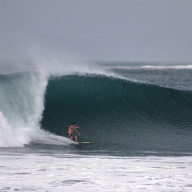(Cannabis Industry Listen Up!)
It was Spring of 2011, and for the first time in my life I had some money in the bank that I could actually go out and use. It wasn’t a huge sum, but enough to buy some land in Central America. So, that’s exactly what I set out to do.
I had travelled through all of Central America several years earlier, so I had a basic idea of where I should focus. Being a surfer, I also knew that buying land near a great wave was a ‘sure bet.’
Surfers, if you aren’t aware, will spend ridiculous amounts of money to surf a great wave. Although there are great waves all over the world, finding a truly consistent and uncrowded wave is like finding a unicorn.
There are many private surf resorts throughout the world that allow their guests access to waves right in front of their property. While these waves aren’t technically private, they are essentially off limits to those not staying at the resort, as you’d have to trespass in order to get to the wave. (Unless you take a boat, but that’s a whole different set of complications and expenses.)
These surf resorts can be pricey too. Some, like the famous Fijian island of Tavarua, also limit the number of people who can be there at one time. That guarantees that there will be enough waves to go around, and of course ensures that prices stay high.

Some surf destinations are cheap, like Bali where you can live on less than $20 per day. (Mosquitoes, annoying hippies, and crowded waves included at no extra charge.)
Other destinations charge fees that would blow your mind. Thousands of dollars per day… PER PERSON. These places include private boat transfers to barrier reefs (where the perfect waves are), helicopter drops, and almost anything you can think of.
So, back to my land hunting expedition back in 2011…
I knew of several places I wanted to look because I had done a ton of research using aerial maps to locate areas that I thought would have great waves. (That’s a science in itself because you have to look at the coastline, what swell direction it can pick up, the fetch length, etc.) I also made sure that these places weren’t already developed.
Long story short, I found some land (that I still own to this day) that was absolutely perfect. It was a total nightmare to make the deal happen. I had to find the owner, who was a random rancher in the middle of the jungle, get surveys done, perform multiple title searches, hire a law firm to draft documents, open local bank accounts, move money, and the list goes on and on.

I was the first outsider to buy land in the area, so it was a little bit of a sore subject with the locals (which I can oddly sympathize with). However, I ensured everyone that I had no plans to turn the land into some kind of Disneyland resort. Instead, I just wanted to sit on it and do nothing… which I am still doing today.
BUT… guess what happened about a year after I bought that land? Someone else came along and bought up a massive amount of land right next to me. They had huge financial backing and literally purchased everything that surrounded me.
However, I still owned the prime land, which is right in front of the main surf break and consists of a small mountain, giving an incredible view to the ocean and surrounding area.
Keep in mind that at the time I didn’t have any experience with investing in foreign real estate, didn’t know anything about developing land, and didn’t have any financial backing from investors. It was just me and my stubbornness.
I was in way over my head.
The guy who bought the land all around me started to infringe on my property line. He repeatedly tried to get surveys done that proved he owned parts of my land, while I repeatedly had to fend off his attacks by way of more and more lawyer fees. In hindsight, I see that he was trying to wear me down so he could buy me out.
But I wouldn’t sell. To him or to anyone.
At the same time that he was giving me a headache, he started to aggressively subdivide the property that he had purchased around me. From the land he bought, he made dozens of smaller lots, maybe each the size of a baseball diamond. He also put in roads, brought in power, and did lots of other improvements.
He sold almost all of the lots he subdivided in a matter of months. He had bought the land for about $40 USD per square meter and then sold those subdivided lots for almost $200 per square meter.
At the time I was furious. Not only had he made me spend tens of thousands of dollars in legal and survey fees, but he had also disrupted the entire area. He turned a bunch of empty land into dozens of tiny lots that new buyers would build homes on.
Furthermore, I felt totally used. I was the first one to go to the area and do all of the hard work of finding the land owner, of smoothing things over with the locals, and most importantly, I identified the area as extremely valuable in the first place. Yet, despite all of that, I wasn’t the one that saw the huge rewards. Instead, the guy who rode my coattails ended up being the one that walked with the biggest winnings.
Now, years later, I realize three lessons:
- A rising tide lifts all boats. This guy actually made my land extremely valuable. He did an enormous amount of work to his property, which ended up increasing the value of mine.
- Everything is cyclical, including things we are involved in. I was truly angry with this guy, who I felt was attacking me and exploiting the area. But, thinking back, what did people think of me when I came in and first bought the land? Probably the same as I thought of him.
- Pioneers take the arrows, settlers take the land. There is no doubt that I was an early investor and I clearly had first mover advantage. However, there is an advantage to coming right after the first movers, as they end up clearing through most of the obstacles.
These three lessons are applicable to nearly every upstart industry I can think of today. For example, many cannabis industry veterans are having extreme heartburn with fears that their market is getting gentrified.
Many long-time cannabis entrepreneurs are claiming that the new players in the industry are ruining the grass roots culture. These new entrants are more concerned about profits instead of ensuring that the the O.G.’s (original growers) are taken care of.
To add salt to their wounds, this past week in Santa Barbara County, 20 tons of illegal cannabis was seized and destroyed during a four day raid carried out by the Sheriff’s department, which was funded by legal cannabis taxes!
At the same time, the legal cannabis industry, which has received billions of dollars through legal investments over the past several years, has accelerated faster than anytime before. Over a dozen US states have legalized the green plant for recreational consumption and even more states have proposed legislation changes in the pipeline.

Internationally, the trend is the same, with many countries considering legalizing recreational cannabis use. There are even countries exporting large amounts of cannabis products to other international trade partners.
Clearly the industry is moving in a forward direction, but it took real money and real business people to come into the market to make it happen. Meanwhile, the O.G.’s are complaining that the industry isn’t unfolding as they wish it would.
Well, why do you think cannabis has all of a sudden been able to move forward? Because real money, with real political relationships, and real experience has suddenly stepped in. Like it or not, that’s the truth.
Just like my experience in Central America, the reality is that forward progress takes people who know what they’re doing. It’s not always pretty and plenty of people will get the short end of the stick, but moving forward is what ultimately makes things for the better.




